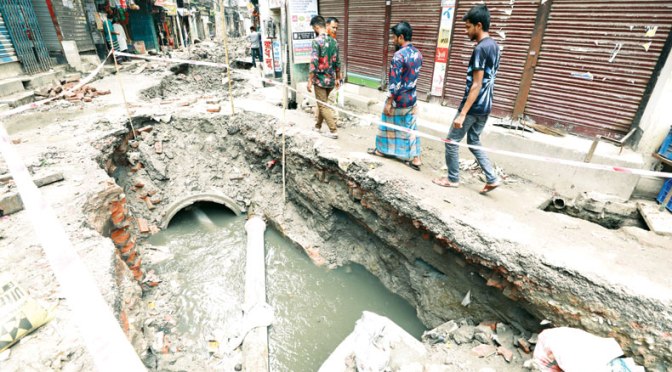The number of cardiovascular patients is increasing very fast in Bangladesh, but the government is yet to take adequate preventive measures and create treatment facilities to meet the high demand.
Cardiologists said that, unlike in the past, a large number of young people were also now suffering from the disease and blamed inactive lifestyles and unhealthy food habits for the rapid spread of the non-communicable disease.
According to the latest National Health Bulletin in 2019, heart disease is the leading cause of mortality, morbidity, and hospital admission in the country.
Health rights activists said that cardiovascular disease treatment remains also very expensive here.
Against this backdrop, Bangladesh will observe World Heart Day today like other places in the world with the theme ‘Use heart for every heart’.
The World Health Organization’s latest Non-Communicable Diseases country profiles 2018 said that 67 per cent of deaths occur in Bangladesh due to non-communicable diseases.
Cardiovascular disease is the leading cause of death by non-communicable diseases, which is about 30 per cent or 2.56 lakh deaths.
It was 1.5 lakh, or 17 per cent, in 2014, according to the global health body, which unveils the report every four years.
Health rights activists said that both the treatment facilities and the number of cardiologists were inadequate in Bangladesh, while urbanisation without health infrastructure was also promoting the deadly disease.
According to the Bangladesh Cardiac Society, the recommended cardiologist population is 2.6 to 4.2 for every 100,000 people. On that count, for 17 crore Bangladeshis, the country requires at least 7,000 cardiologists.
But Bangladesh currently has only around 1,000 cardiologists, including 200 cardiovascular surgeons, said Bangladesh Cardiac Society secretary general Abdullah Al Shafi Majumder.
Abdullah Al Shafi, however, said that the situation was improving with the establishment of new cardiac centres through private initiatives.
He estimated that presently there are only 50 hospitals in Bangladesh with cath lab facilities for the advanced treatment of heart patients.
The cath lab is the most basic equipment required in a cardiac unit hospital, consisting of an Angiography X-Ray system.
Of the 50 hospitals with cath lab facilities, 30 are in Dhaka, including six state-run hospitals, he said.
The majority of the hospitals with cath lab facilities are privately owned, which makes heart treatment costly.
The crisis of expert nurses and technicians is also acute, he said.
The National Institute of Cardiovascular Diseases director, Mir Md Jamal Uddin, said there was huge pressure in their hospital for treatment costs here, which is much cheaper than in private hospitals.
Abul Kalam, the attendant of Sathi Begum, 32, a heart patient admitted to NICVD, said that he could find a seat here for his wife two months after she was diagnosed with a block in her heart.
He said that he failed to get Sathi admitted to the hospital several times as the authorities informed him that there was no seat available.
NICVD director Jamal Uddin said they increased the number of beds to 1250 from 450 in recent years yet could not accommodate all patients who were coming for heart treatment.
He said that not only beds, but the hospital also needed more equipment and manpower as it was operating with the same manpower allocated for 450 beds.
‘The number of patients has increased three times, but there has been no change in the recruitment structure in the past 20 years,’ he said.
With the limited manpower and inadequate infrastructure, the hospital was providing treatment to over 1,300 indoor patients and many outdoor patients every day, he said.
On Wednesday, 1,307 patients were admitted to the hospital.
NICVD sent a requisition for 2,400 people, including 1,100 nurses and 400 doctors, in 2021 and was waiting for approval, he said.
Md Delwar Hossain, a resident of Bikrampur in Munshiganj who was undergoing treatment at the NICVD, said that he sold out his land and cattle for his treatment. He spent over Tk five lakh in the two and a half months since his disease was diagnosed.
In government facilities, the fees for surgery begin with Tk 1.10 lakh while the lowest fee in private hospitals is around Tk 3.0 lakh, said medical professionals.
Around 10,000 cardiac surgeries are done in those hospitals each year, they said, adding that a large number of patients also go abroad for treatment.
Sohel Reza Choudhury, Professor at the National Heart Foundation Hospital and Research Institute, said that the number of heart patients is on the rise due to unhealthy lifestyles and food habits.
He said that excessive salt, sugar, junk food, and inadequate physical exercise are among the main causes of heart diseases, adding that stress and hypertension are also contributing.
Bangabandhu Sheikh Mujib Medical University Hospital cardiology Professor SM Mustafa Zaman said that tobacco and alcohol were another two causes of the disease.
‘We want a ban on tobacco that is also responsible for some other diseases,’ he said.
According to the WHO, 26 per cent of the adult population in Bangladesh is physically inactive, 23 per cent use tobacco, 21 per cent have high blood pressure, eight per cent have diabetes, and three per cent are obese.
Zaman said that millions of people are unaware of the disease but they are suffering.
‘It is a silent killer. People having heart disease, in many cases, do not have symptoms, and thus casualties increase,’ he said.
He asked for screening of all those aged over 18.
Health Service line director Masud Reza Kabir said that the government introduced the Non-Communicable Disease Corner in 54 hospitals across the country to check all types of NCDs, including cardiac diseases.
The government is working to expand it to 200 by 2023 and across the country by 2025, he said.
He said that the government is also working to set up hospitals in all divisions with cardiac facilities.
The country has no rehabilitation and post-surgery care services, which doctors said prevented surgery patients from returning to normal life.
published on New Age



